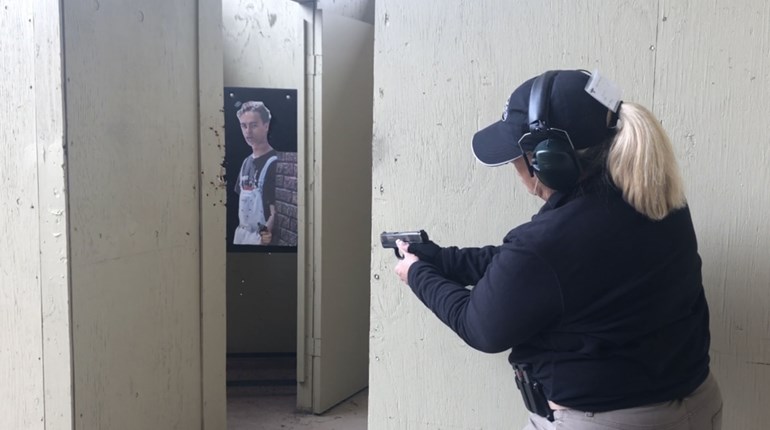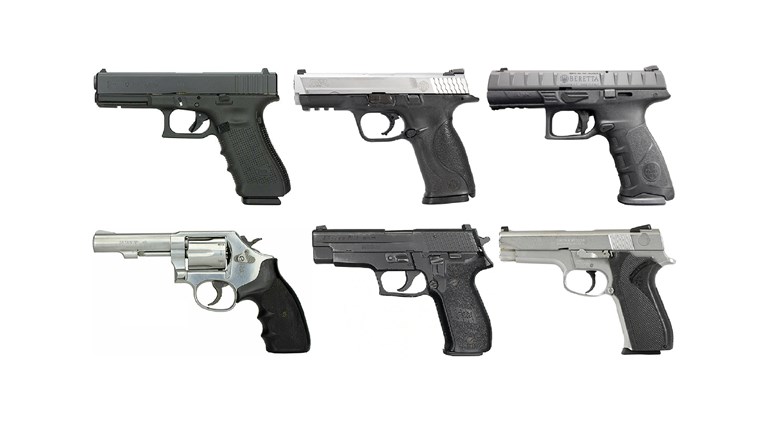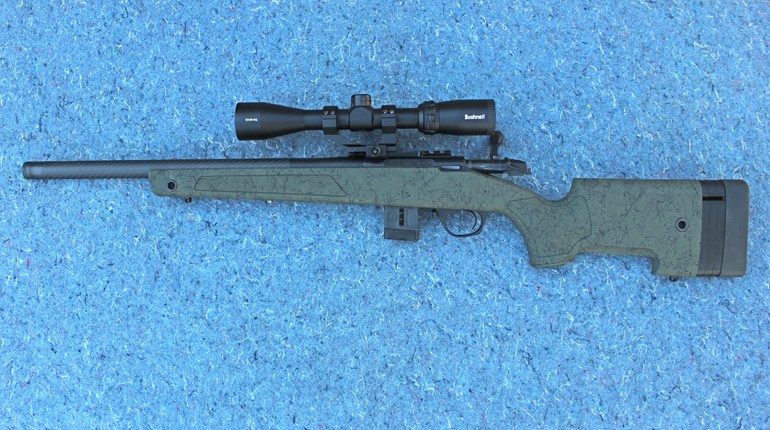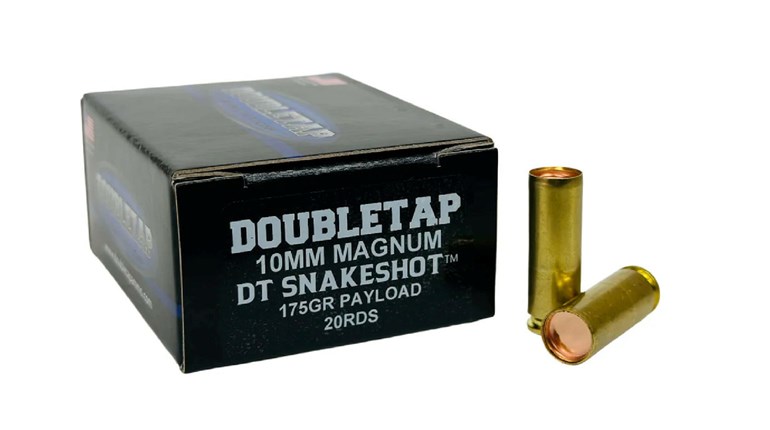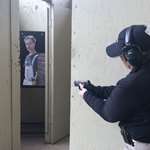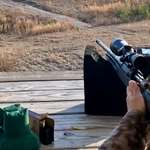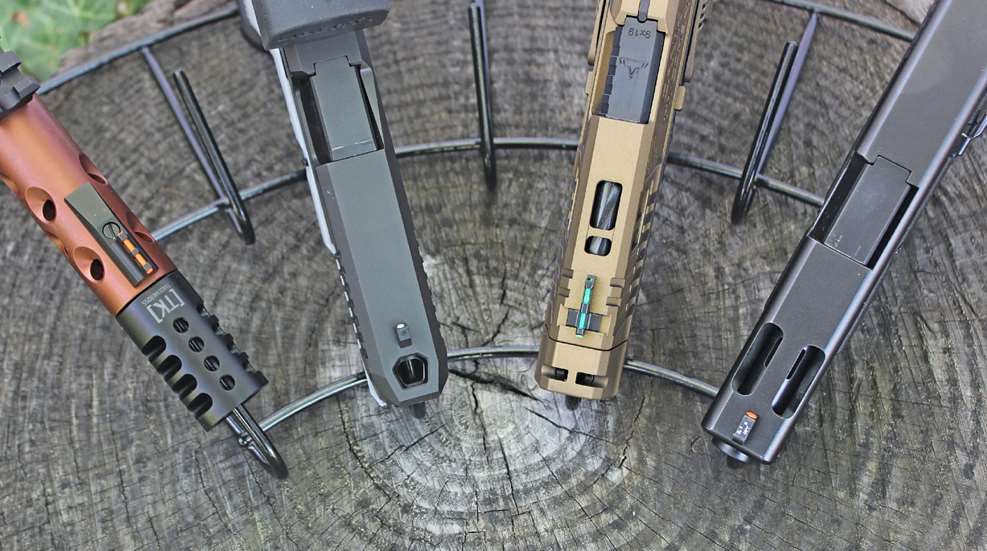
Over the last 25 years or so, we've seen the features of polymer-framed, semi-automatic pistols intended for personal protection continuously evolving. Night sights fitted with tiny green tritium lamps that glow in the dark are readily available now. Molded-in dust-cover accessory rails became a must-have feature to support laser sight and flashlight modules. The “Micro Nines” category has grown significantly and, over the last few years, the latest-and-greatest gotta get it defensive pistol feature has been optics-ready slides installed at the factory.
But now that optics-ready is well established as an industry standard, I thought we might see the start of some other trend at this year's SHOT Show in Las Vegas, Nevada. Sure enough, it was there, but what I found made me do a double take! Several polymer-framed, 9 mm pistols intended for self defense were outfitted with compensators or had compensated barrels. Why did I scratch my head at this? Let's take a little trip down memory lane.
Poking Holes in Revolver Porting
If we set the Wayback Machine for roughly around the start of this century, short-barrel revolvers chambered in potent calibers like .357 Mag. were much more popular than they are today. But anyone who has touched off full-power magnum loads in a snubby 5 or 6-shot wheel gun knows that the recoil can be quite impressive. The jarring kick contributes to muzzle flip, or muzzle rise, which is the muzzle lifting up and away from the direction of the intended target. As a result, it takes more time and effort on the part of the self defender to bring the revolver back into alignment with the target, reform the sight picture and fire the next round.
Thus, one of holy grails of defensive handgun design over the years has been to reduce muzzle flip as much as possible while maintaining a level of ammunition performance (accuracy and bullet energy) suitable for defensive situations. This is one of the reasons that semi-automatic pistols chambered in calibers like 9 mm and 5.7x28 mm have become so popular. The recoil with these rounds is moderate which makes muzzle rise more manageable than with some of the larger pistol calibers or big bore revolvers.

The Taurus 692 dual-cylinder revolver currently features four round ports to either side of the front sight to reduce muzzle flip.
Getting back to the snub-nose revolvers, the self defender has a few options for managing the muzzle and the recoil. They can practice regularly, go to the gym, eat their spinach and learn to ride the pressure wave their gun and ammunition combination produces. Another option is to reduce the conclusiveness by using reduced power ammunition. Many of the .38-caliber revolvers in use today are common stoked with .38 Special +P cartridges which effectively split the performance, and recoil, difference between the more modest .38 Spl. and potent .357 Mag.
But there is a third option, which is the topic of this conversation. It became quite popular for a while to “compensate” for muzzle rise by drilling a series of ports (holes), or cutting a pair of vents, into the revolver's barrel to either side of the front sight. As the bullet leaves the barrel, this ventilation system re-directs a portion of the hot gasses produced by the ignition of the cartridge's powder. The gas blowing up and out of the ports pushes the muzzle downward. When the gun, the ammunition and the porting system are all properly aligned, the result is a reduction is muzzle rise and, in some cases, levels of felt recoil. Porting a revolver's barrel works and it's mechanically simple to do. So what's not to like?

The threaded barrel of the Ruger MkIV 22/45 Lite can be fitted with various muzzle devices, including TK Game Changer compensator.
In the case of the short-barrel magnum revolvers (3" or less), the gun gurus of the day were quick to point out the trade-offs that come with compensated barrels. First off, the porting can make the revolver's report significantly louder. Ramping up the noise for an already noisy gun is not beneficial for the person pulling the trigger. The noise will be even more deafening if they must fire in a confined space like a hallway or the interior of a vehicle. Next, the barrel ports can make the muzzle flash brighter. Like the noise level, a more blinding muzzle flash is not helpful to the defender.
Finally, using a compensated barrel on any handgun means the heat and pressure from the burning powder charge behave like a momentary blowtorch. With a revolver, those gases already blow out sideways from the cylinder gap and forward out of the muzzle. The ports on top of the barrel send those hot gases in a third direction. The argument against porting at the time was that in situations where a person protecting himself had to fire the revolver with it held close to his own body, the vents on top of the barrel might be pointed toward their face or arm, resulting in serious injury.

Glock offered compensated .40 S&W pistols for about a decade, including the Gen 3 G23C shown here.
In the end, the general consensus was that compensating a revolver's barrel to reduce muzzle rise was a useful feature if that particular gun would be used for target shooting or handgun hunting, like the Taurus 692 Tracker multi-purpose, caliber-convertible revolver. But the added noise, muzzle flash and tri-directional gas release should be avoided in most cases regarding defensive revolvers. As a result, most medium- and small-frame revolvers with shorter barrels made today continue to leave the factory with unventilated barrels.
Compensating for Semi-Automatic Pistols
I took the time to reflect on the ported defensive revolver debate here because it spilled over into the semi-automatic pistol side of the conversation as well. The results were similar, but not exactly the same.
Compensators for semi-automatics are, on the whole, much more popular than they ever were for wheelguns. This is due in large part to the ease with which pistol barrels can be swapped out. A flush-fit barrel can be removed from the slide and replaced with a slightly longer threaded barrel, no gunsmithing required. Once a threaded barrel is installed, it can be used with a variety of twist-on muzzle accessories, including external compensators. The Ruger MkIV .22 LR target shooting pistol ships with a threaded muzzle as a standard feature. It's shown here with a Tandemkross Game Changer compensator installed.

Glock opted to compensate their pistols using pairs of vents instead of a series of round ports milled into the barrel.
However, muzzle devices make pistols physically longer by an inch or two. This is not all that conducive to concealed carry or staging handguns in quick-access lock boxes at home. So the removable compensators are primarily reserved for competition and related sporting endeavors.
That brings us back to what are now better known as compensated, or “comped” semi-automatic pistols. Much like the revolvers discussed earlier, these pistols have ports or vents cut directly into the barrel with matching openings milled into the slides. A representative old-school example of this are the “C” versions (the C standing for Compensated) of various Glock Gen 3 models, which started shipping back in 1994.
Shown in the photos is a third generation model G23C, which is a Compact size pistol chambered in .40 S&W. Removing the barrel from the slide makes it easier to see the right and left side vents located half way between the chamber and the muzzle. But cutting the vents this close to the chamber affects ammunition performance as well as muzzle rise.

The Lone Wolf Arms Alpha Wolf pistol is based on the popular full-size 9 mm Glock G17.
Once a bullet passes a set of vents or barrel ports, it stops gaining speed due to the sudden drop in gas pressure. In the case of the Glock G23C, the 4.02" barrel now only develops about 2.5" worth of bullet velocity. The combination of the vents blowing upward and the bullet leaving the gun more slowly noticeably reduces felt recoil. But the trade off is reduced bullet energy, a louder bang and essentially three muzzle flashes. In the end, this particular pistol is basically a .40 S&W that handles like a 9 mm but with extra steps using more expensive ammunition. By 2014, all of the .40 S&W Glock C models were completely dropped from production as most folks opted to just use 9 mm Glocks instead.
But compensated 9 mm pistols, be it built-in compensator porting, removable external compensators or the somewhat exotic integrated compensators, have found a home within the competitive shooting community. The full-size, black and gray custom Alpha Wolf 9 mm pistol from Lone Wolf Arms is a good example of the mono-port designs currently in circulation. Notice how the port is as far forward on the barrel as possible. This keeps the gas pressure from dropping until the bullet is within about half an inch of leaving the gun, thus preserving most of the bullet’s velocity.
Another ported model on display at SHOT Show this year is the brand new black and bronze Canik TTI Combat, imported by Century Arms. In this case, the company installs an integrated external compensator. Rather than threading the slightly longer barrel, the portion that protrudes past the slide has a weight pinned to it with two small ports that vent the gasses upwards and sideways in a “V”-shaped pattern. They designed the ports this way for an important reason.

This Alpha Wolf slide has a single five-sided port located as close to the muzzle as possible.
So far we've touched on three primary limitations of porting including increased noise, greater muzzle flash and multi-directional muzzle blast. But modern defensive pistols add a fourth wrinkle to the equation: micro red-dot optics. Are the ports going to blow hot, greasy fouling and debris into the lens of the optic? More recent port configurations take the optics into consideration. The Alpha Wolf single five-sided port angles the gases slightly forward and away from both the optic and the shooter. The Canik TTI Combat's “V” ports protect the lens while directing the flash away from the front sight and optic's red dot aiming point.
Why Are Comped 9 mm Pistols Showing Up Now?
Acknowledging that barrel ports succeed at reducing muzzle flip, but at a price, why are they making a comeback now? The two reasons that stand out for me are first, a fundamental shift in defensive handgun training strategies, and secondly, good ol' marketing strategies.

The central position of the G23C barrel’s vents (left) can cause a drop in bullet velocity while the Alpha Wolf port (right) gives bullets more time to pick up speed before leaving the pistol.
Let's start with defensive training. As I walked the SHOT Show floor, I found some handgun instructors and asked them why they thought we were seeing more comped 9 mm pistols this year. Their responses can be summed up this way. In the past, instructors put an emphasis on the first shot fired by the self defender. The gun draw needed to be quick, smooth and efficient since the first shot fired towards an assailant could likely determine the outcome of a potentially life and death fight.
Today, the defensive philosophy has changed. In the past, if someone had to defend themselves it was more likely that they would be confronted by a singular threat. But in recent years more criminals are choosing to work in teams of two or more. As a result, the self-defense courses have shifted their training from focusing on the first shot to being prepared to engage multiple threats.

The Century Arms Canik TTI Combat pistol features an integrated compensator located in front of the slide.
This is where the barrel porting comes in. Additional rounds may need to be fired more quickly in order to engage multiple threats. Since comped barrels reduce muzzle rise and can contribute to increased speed and accuracy, the trade-offs are worth it. And to be fair, porting a 9 mm pistol does not produce the levels of noise and flash one gets with comped big-bore pistols or revolvers. When I took the ported Alpha Wolf to the range recently, it was louder and brighter than some other full-size pistols I've worked, but not monumentally more. The increase was not that much greater than shooting the same ammunition through sub-compact pistol length barrels.
In regard to the marketing angle, firearms manufacturers are always looking for ways to either make their guns stand out from the crowd or to ensure they are in harmony with recent trends. We are currently enjoying a kind of defensive pistol golden age in which high quality at fair prices is available across a variety of reputable brands, including several imported models. Today's defensive pistols are feature rich with factory upgrades that used to require custom work just a few years ago.

The TTI Combat pistol’s compensator vents the gases in a V-shaped pattern.
The 9 mm cartridge is now the go-to caliber, so there’s nothing new or exciting to talk about caliber wise. Polymer frames have prevailed and their dust covers have accessory rails for light or laser sight modules. Slides sport front and rear cocking serrations, diamond-like carbon finishes, upgraded sights and they are milled, drilled and tapped for micro red dot optics. Folks, there's just not all that much real estate left on the outside of the pistols to be spiced up except for right up and around the muzzle. That leaves porting the barrels, which is a relatively straight forward feature for manufacturers to install.
Compensated Defensive Handgun: A Fix or A Fad (Again)?
After looking over the pros and cons, is it time for you to rush out and join the comped 9 mm pistol club? As with any other defensive pistol choice, the answer is a firm maybe. Which features are best all depends on the needs and preferences of the self defender.

The Alpha Wolf’s single barrel port (left) compared to the twin ports of the TTI Combat’s compensator (right).
Does compensating a 9 mm pistol create enough of a difference in muzzle flip to make a difference for you? For some it will and for others it won't. If recoil and muzzle control are a concern, are there other ways to manage them? Would additional training and practice to develop skills provide improved control without the added noise and muzzle flash of barrel porting? Would it be a better fit to switch to a different model of 9 mm pistol that fits your hands better? Or, perhaps it’s time to switch to a softer shooting caliber.

The Alpha Wolf’s integrated compensator port (left) is cut directly into the barrel and the slide while the TTI Combat’s slightly extended barrel (right) allows the compensator to rest in front of the slide.
Here are a few things to keep in mind before shelling out any of your hard-earned cash. Just because a feature is trending does not automatically mean it's the right option for everyone. Also, the needs and goals of self-defenders do not always align with those of competitive shooters and law enforcement (that's a discussion for another day). Finally, if you've done your homework and a comped 9 mm does look like a good fit, then do your best to try it before you buy it by renting one from a shooting range or borrowing it from a friend for a test drive.
Will ported defensive pistols be the next big thing? Only time will tell. I own and shoot compensated handguns in various roles, so I can see why ported defensive pistols are coming back into fashion. But they've been here before and didn't stick around for all that long.

Featured Handguns:
Century Arms Canik TTI Combat 9 mm
Glock Gen 3 G23 .40 S&W (Compensated Models Discontinued)
Lone Wolf Arms Alpha Wolf Slide Assembly (F1GLK22G3) with Alpha Wolf Large Frame
Ruger MkIV 22/45 Lite
Taurus 692 Tracker 7-Shot .357/9 mm Convertible












